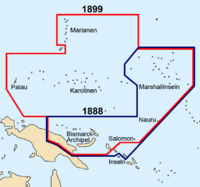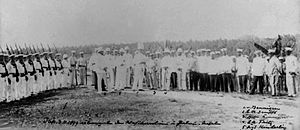German–Spanish Treaty (1899) facts for kids

Borders of German New Guinea before (in blue) and after (in red) the 1899 German-Spanish treaty
|
|
| Type | Bilateral treaty |
|---|---|
| Signed | 12 February 1899 |
| Parties | |
The German–Spanish Treaty of 1899 was an agreement between the German Empire and the Kingdom of Spain. It was signed on February 12, 1899. In this treaty, Spain sold most of its islands in the Pacific Ocean to Germany. These were islands Spain still owned after losing many others in the Spanish–American War. Germany paid 25 million pesetas for them. This was about 17 million German Marks at the time.
Contents
A New Chapter for Pacific Islands
This treaty marked a big change for many small islands in the Pacific. Spain had owned these islands for a long time. But after losing a war, they decided to sell them.
Spain's Changing Empire
During the 1800s, Spain's large empire started to shrink. Many of its colonies in the Americas fought for and won their freedom. Then, in 1898, Spain fought the Spanish–American War. This war caused Spain to lose even more of its colonies.
After the war, Cuba became an independent country. The United States took control of Puerto Rico. The U.S. also gained the Philippines and Guam in the Pacific Ocean. These had been important Spanish colonies.
Why Spain Sold the Islands
After the war, Spain was left with only a few small islands in the Pacific. There were about 6,000 of them. These islands were tiny, had few people, and were not very rich in resources. It was hard for Spain to rule them. This was especially true after they lost Manila, which was their main administrative center in the Pacific. Spain also couldn't defend the islands anymore. Their navy had been badly damaged in the war.
Because of these problems, the Spanish government decided to sell the remaining islands. Germany was very interested in buying them. Germany wanted to expand its own colonial empire.
The Treaty's Impact
The Spanish Prime Minister, Francisco Silvela, signed the treaty on February 12, 1899. This agreement officially gave the Caroline Islands and the Northern Mariana Islands to Germany. Germany then placed these islands under the control of German New Guinea. Palau, which was considered part of the Carolines back then, was also taken over by Germany. The Germans soon began mining for resources there.
The United States could have kept these islands. But they didn't show enough interest at the time. So, Spain kept control until the sale to Germany.
What Happened Next
Years later, in October 1914, World War I began. During this war, the Empire of Japan invaded many of these German-owned islands. Japan took control of them.
After World War I ended, these islands became part of the South Seas Mandate. This was a special territory managed by Japan under the League of Nations. The League of Nations was an organization created to promote peace.
Later, during and after World War II, the United States took control. The U.S. gained power over these Pacific islands that had once belonged to Spain and then to Germany and Japan.
Unanswered Questions About Islands
For a while, some people wondered if Spain still owned a few islands. These islands included Kapingamarangi, Nukuoro, Mapia, Rongrik, and Ulithi. There was also a place called "Matador," which might have been a reef that later sank. The idea was that these islands were not clearly given to the United States or Germany in the treaty.
In 1948, a Spanish lawyer named Emilio Pastor y Santos suggested this idea. He thought Spain should set up naval bases on some of these islands. However, the Spanish government looked into it. In 1949, they decided that any claim Spain might have had was gone. This was because of new agreements made after World War I and World War II. These agreements gave control of the islands to Japan and then to the United States.
In 2014, the Spanish government officially stated that Spain does not own any Pacific islands anymore. They explained that when Spain signed the treaty with Germany in 1899, the goal was to give up all its remaining Pacific possessions. It wouldn't make sense for Spain to keep a few small, less important islands.
Today, Mapia is part of Indonesia. Kapingamarangi, Ulithi, and Nukuoro are part of the Federated States of Micronesia. Rongerik is controlled by the Marshall Islands.
See also
 In Spanish: Tratado germano-español (1899) para niños
In Spanish: Tratado germano-español (1899) para niños


